It looks like you're using an Ad Blocker.
Please white-list or disable AboveTopSecret.com in your ad-blocking tool.
Thank you.
Some features of ATS will be disabled while you continue to use an ad-blocker.
share:
- yet you Go Delude people
Delude Souls
now thát is a Serious Crime
i tell you - before Heaven -
that many souls YOU have Deluded will chase you, screaming
saying you "WHY have you put us on the wrong track
cause we believed it - and now we are Doomed "
think im joking?
- just wait a few weeks.
Delude Souls
now thát is a Serious Crime
i tell you - before Heaven -
that many souls YOU have Deluded will chase you, screaming
saying you "WHY have you put us on the wrong track
cause we believed it - and now we are Doomed "
think im joking?
- just wait a few weeks.
" what harmony has Christ with Belial ? "
2 Cor 6:15
...yet "muzzleflash" thinks he knows bétter...?
pitching Truth and Mimick against oneanother,
thinking, from his Limited perception, that "both are false, anyway",
thinking that from his vieuw onto this "reality" - the same reality, infested by Evil...?
you just wait Muzzle
untill the next Dimensions will open up
...you just wait.
2 Cor 6:15
...yet "muzzleflash" thinks he knows bétter...?
pitching Truth and Mimick against oneanother,
thinking, from his Limited perception, that "both are false, anyway",
thinking that from his vieuw onto this "reality" - the same reality, infested by Evil...?
you just wait Muzzle
untill the next Dimensions will open up
...you just wait.
reply to post by Lone12
Let's compare your attitude and threats/condemnation with the Bible:
Or maybe...
This thread is about showing everyone who the Real "Hissing Snake" is.
The "Hissing Snake" is found only in the Mirror. $$$
Think about that and these Bible quotes a bit it's really enlightening.
Thanks for posting though, nice to see interest in these topics.
Will continue shortly with more content and possibly consider shifting gears into something totally unexpected...hmmmm....
Let's compare your attitude and threats/condemnation with the Bible:
Matthew 7:1-5 ESV
“Judge not, that you be not judged. For with the judgment you pronounce you will be judged, and with the measure you use it will be measured to you. Why do you see the speck that is in your brother's eye, but do not notice the log that is in your own eye? Or how can you say to your brother, ‘Let me take the speck out of your eye,’ when there is the log in your own eye? You hypocrite, first take the log out of your own eye, and then you will see clearly to take the speck out of your brother's eye.
Or maybe...
Romans 14:1-23 ESV
As for the one who is weak in faith, welcome him, but not to quarrel over opinions. One person believes he may eat anything, while the weak person eats only vegetables. Let not the one who eats despise the one who abstains, and let not the one who abstains pass judgment on the one who eats, for God has welcomed him. Who are you to pass judgment on the servant of another? It is before his own master that he stands or falls. And he will be upheld, for the Lord is able to make him stand. One person esteems one day as better than another, while another esteems all days alike. Each one should be fully convinced in his own mind. ...
1 Corinthians 4:1-21 ESV
This is how one should regard us, as servants of Christ and stewards of the mysteries of God. Moreover, it is required of stewards that they be found trustworthy. But with me it is a very small thing that I should be judged by you or by any human court. In fact, I do not even judge myself. For I am not aware of anything against myself, but I am not thereby acquitted. It is the Lord who judges me. Therefore do not pronounce judgment before the time, before the Lord comes, who will bring to light the things now hidden in darkness and will disclose the purposes of the heart. Then each one will receive his commendation from God. ...
This thread is about showing everyone who the Real "Hissing Snake" is.
The "Hissing Snake" is found only in the Mirror. $$$
Think about that and these Bible quotes a bit it's really enlightening.
Thanks for posting though, nice to see interest in these topics.
Will continue shortly with more content and possibly consider shifting gears into something totally unexpected...hmmmm....
edit on 9-9-2013 by
muzzleflash because: (no reason given)
edit on 9-9-2013 by muzzleflash because: (no reason given)
Totally jamming this morning.
Tapping into the flow, the force, the preferred course.
All I see is Medusa. Janus is Medusa.
We all bow to the Head, hate it love it or indifferent.
It's on your coins, it's on the dollar bill.
"IN GOD WE TRUST"
The Guardian with the Gaze of Death.
Elohut
Ousia
Divinity
The GodHead
Pay attention to the illogical claim.
I am quoting this ::
Unrelated?
Even though "Hoods" go on "Heads"?
Having "Godhood" is like being the "Head" aka the best, the top, the boss.
Even though the two very words are confused in this very terminology "Godhead - Godhood"?
Hood = Cloak / Hidden / Deception / Shadows / Concealment.
Comes from "Hat" supposedly...
Aha! Protect! The Guardian of the Abyss!
Helmet? With Hel?
The God Head?
We may not realize it, but the clues abound everywhere around us.
Met comes from "with/together", so "Helmet" would be a dual meaning.
It means "With Hel", or being with the Guardian so to speak, and the "Metal" protects your Head from having to actually have to "Meet Hel".
So this would mean "Metal" could easily be interpreted accurately and correctly as "With Material/Substance/Stuff".
"Related Somehow" to "Seeking After"? Of course it is!
Mine, Miner, Mining, Mined, etc.
Pit? You know that Ultimate Bottomless Pit?
The Mystical Golden Mine of the Mind of the God Head?
Meet All = With Substance = Metal = 'Stuff'
Isn't that bizarre? Gem and Eye.
When you mine the Gem you will have your Eye.
The Stone of All Knowing? The Rock of God??
The Foundation of All?
God is "The Rock".
Shield + Horn
You know, the Trumpeting Guardian the ultimate Trump ?
That's one horn, the "Horn of the Unicorn".
So take your "Query" to the Eternal "Quarry".
So if Mining and Querying are the same essentially, than what is a "Quarry" anyways?
Oh, that's the place where we get squared up.
Trapped (Frozen into Stone), Confronted (By the Cosmic Serpent).
Having to settle something.
This is the Roc of Mythology.
The Roc of God, that Giant Bird.
"which shakes the ripe fruit from the mythical tree that bears the seed of all useful things."
What is the Blessed Piece of Wood?
It is the "Word" of course. The "Truth".
The "Ripe Fruit" from the 'Tree that bore All'.
Roc = Chimera (composite of animals) = Loud Harpy (it's cry was very loud) = Thunder God (it's sound was as loud as thunder and possibly even caused earthquakes) = Grim Reaper (carries you off for dinner).
And of course "Rocking" is "Back and Forth", which is the Duality Concept.
The cosmic battle between the Feathers and the Scales, the Bird and the Snake, the Sky and the Earth.
Remember it is the Feather of Maat that Weighs your Heart on the Scales ?
And of course we are back to the "flying mountain, the roc".
Because we are Mining our Minds, Querying the Quarry, sifting for that Golden Nugget, looking for the Gem that is the Eye of I.
Tapping into the flow, the force, the preferred course.
All I see is Medusa. Janus is Medusa.
We all bow to the Head, hate it love it or indifferent.
It's on your coins, it's on the dollar bill.
"IN GOD WE TRUST"
The Guardian with the Gaze of Death.
Elohut
Ousia
Divinity
God in Hinduism
Brahman, the divine source of being, through which all emanates
Paramatma, the "oversoul" or supreme spirit
Three godheads (Ayyavazhi) or Trimurti, Brahmā, Vishnu and Śhiva
Svayam Bhagavan or Supreme Personality of Godhead, in Gaudiya Vaishnavism, the divine person from whom all emanates
The GodHead
Pay attention to the illogical claim.
I am quoting this ::
Godhead (from Middle English godhede, "godhood", and unrelated to the modern word "head"), may refer to:
Unrelated?
Even though "Hoods" go on "Heads"?
Having "Godhood" is like being the "Head" aka the best, the top, the boss.
Even though the two very words are confused in this very terminology "Godhead - Godhood"?
Hood = Cloak / Hidden / Deception / Shadows / Concealment.
Comes from "Hat" supposedly...
Old English hæt "hat, head covering," from Proto-Germanic *hattuz "hood, cowl" (cf. Frisian hat, Old Norse hattr), from PIE root *kadh- "cover, protect" (cf. Lithuanian kudas "tuft or crest of a bird," Latin cassis "helmet").
Aha! Protect! The Guardian of the Abyss!
Helmet? With Hel?
The God Head?
We may not realize it, but the clues abound everywhere around us.
Met comes from "with/together", so "Helmet" would be a dual meaning.
It means "With Hel", or being with the Guardian so to speak, and the "Metal" protects your Head from having to actually have to "Meet Hel".
So this would mean "Metal" could easily be interpreted accurately and correctly as "With Material/Substance/Stuff".
mid-13c., from Old French metal "metal; material, substance, stuff" (12c.), from Latin metallum "metal; mine, quarry, mineral, what is got by mining," from Greek metallon "metal, ore" (senses only in post-classical texts; originally "mine, quarry, pit"), probably from metalleuein "to mine, to quarry," of unknown origin, but related somehow to metallan "to seek after." Cf. Greek metalleutes "a miner," metalleia "a searching for metals, mining."
"Related Somehow" to "Seeking After"? Of course it is!
Mine, Miner, Mining, Mined, etc.
Pit? You know that Ultimate Bottomless Pit?
The Mystical Golden Mine of the Mind of the God Head?
Meet All = With Substance = Metal = 'Stuff'
gem (n.)
Old English gimm "precious stone, gem, jewel," also "eye," from Latin gemma "precious stone, jewel," originally "bud," perhaps from the root *gen- "to produce," or from PIE *gembh- "tooth, nail."
Isn't that bizarre? Gem and Eye.
When you mine the Gem you will have your Eye.
The Stone of All Knowing? The Rock of God??
The Foundation of All?
2 Samuel 22:3
my God is my rock, in whom I take refuge, my shield and the horn of my salvation. He is my stronghold, my refuge and my savior-- from violent people you save me.
God is "The Rock".
Shield + Horn
You know, the Trumpeting Guardian the ultimate Trump ?
That's one horn, the "Horn of the Unicorn".
So take your "Query" to the Eternal "Quarry".
1530s, quaere "a question," from Latin quaere "ask," imperative of quaerere "to seek, look for; strive, endeavor, strive to gain; ask, require, demand;" figuratively "seek mentally, seek to learn, make inquiry," probably ultimately from PIE *kwo-
So if Mining and Querying are the same essentially, than what is a "Quarry" anyways?
quarry (n.2)
"open place where rocks are excavated," c.1400 (mid-13c. as a place name), from Medieval Latin quareia, dissimilated from quarreria (mid-13c.), literally "place where stones are squared," from Latin quadrare "to square" (see quadrant).
Oh, that's the place where we get squared up.
Trapped (Frozen into Stone), Confronted (By the Cosmic Serpent).
Having to settle something.
rock (n.1) Look up rock at Dictionary.com
"stone, mass of mineral matter," c.1300, from Old English rocc (e.g. stanrocc "stone rock or obelisk") and directly from Old North French roque, which is cognate with Medieval Latin rocca (8c.), from Vulgar Latin *rocca, of uncertain origin, according to Klein sometimes said to be from Celtic (cf. Breton roch).
This is the Roc of Mythology.
The rukh is also identified in the Ethiopian holy book Kebra Negast as the agent responsible for delivering the blessed piece of wood to King Solomon which enabled the great king to complete the Temple.
The roc is hardly different from the Middle-Eastern `anqa "عنقاء" (see phoenix); it is also identified with the Persian simurgh, the bird which figures in Ferdowsi's epic as the foster-father of the hero Zal, father of Rustam.
Going farther back into Persian antiquity, there is an immortal bird, amrzs, or (in the Minoi-khiradh) slnamurv, which shakes the ripe fruit from the mythical tree that bears the seed of all useful things. In Indian legend the garuda on which Vishnu rides is the king of birds (Benfey, Panchatantra, 98). In the Pahlavi translation of the Indian story as represented by the Syrian Kalilag and Damnag (ed. Gustav Bickell, 1876), the simurgh takes the place of the garuda, while Ibn al-Molaffa (Calila et Dimna, ed. De Sacy, p. 126) speaks instead of the `anl~a. The later Syriac, curiously enough, has behemoth—apparently the behemoth of Job—transformed into a bird. The Hungarian Turul, the Ziz or Bar Juchne of Jewish tradition, the Fijian kanivatu, Finnish kokko, the Chinese peng and the Thunderbird of Native American tradition are also giant birds.
The Roc of God, that Giant Bird.
"which shakes the ripe fruit from the mythical tree that bears the seed of all useful things."
What is the Blessed Piece of Wood?
It is the "Word" of course. The "Truth".
The "Ripe Fruit" from the 'Tree that bore All'.
the Māori legend of Te Hokioi or Te Hakawai.[13] This was said to be a colorful huge bird which (in some versions of the legend) in ancient times had occasionally descended to Earth to carry off humans to eat, but generally lived in the clouds unseen. Only its cry, after which it was named, could be heard. Indeed, the hokioi seems to be a composite mythical beast inspired by actual animals, just like the roc appears to have been.
Roc = Chimera (composite of animals) = Loud Harpy (it's cry was very loud) = Thunder God (it's sound was as loud as thunder and possibly even caused earthquakes) = Grim Reaper (carries you off for dinner).
And of course "Rocking" is "Back and Forth", which is the Duality Concept.
The roc had its origins, according to Rudolph Wittkower, in the fight between the Indian solar bird Garuda[3] and the chthonic serpent Nāga. The mytheme of Garuda carrying off an elephant that was battling a Crocodile appears in two Sanskrit epics, the Mahabharata (I.1353) and the Ramayana (III.39). The roc appears in Arabic geographies and natural history, popularized in Arabian fairy tales and sailors' folklore. Ibn Battuta (iv. 305ff) tells of a mountain hovering in air over the China Seas, which was the roc.[4]
The cosmic battle between the Feathers and the Scales, the Bird and the Snake, the Sky and the Earth.
Remember it is the Feather of Maat that Weighs your Heart on the Scales ?
And of course we are back to the "flying mountain, the roc".
Because we are Mining our Minds, Querying the Quarry, sifting for that Golden Nugget, looking for the Gem that is the Eye of I.

"Illustration by Friedrich Johann Justin Bertuch"
This is another interesting piece of art.
We have plenty of alchemy here.
The Roc is essentially the Eagle/Hawk motif and the Phoenix.
The Bird of Paradise, the Toucan, the Thunderbird.
Standing on this Roc is the Gatekeeper, the Guardian of the Abyss.
The Queen(King) of Heaven and Hel, etc etc.
The Harpy Queen.
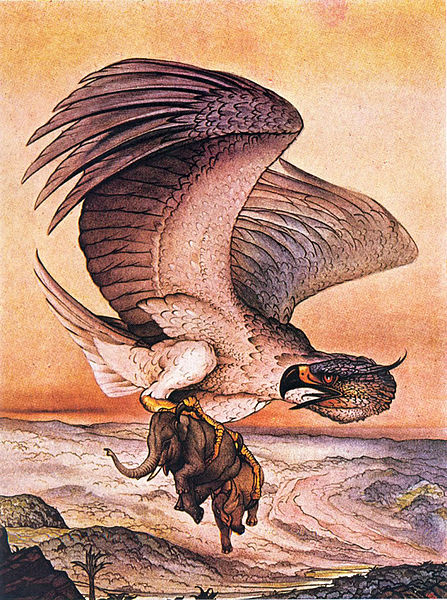
The Roc carrying the Elephant and the Rhino. Trinity concept.
The Roc has one horn, the Elephant shows only one horn, and the Rhino's horn splits into two.
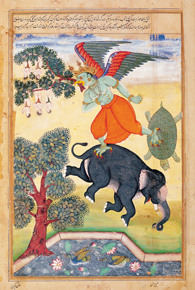
Garuda flying with Vibhāvasu and Supraťika captured in his claws, and bearing a huge branch of a tree
The Mystical Branch of the Tree, carrying the Elephant and the Turtle.
Garuda
The Garuda (Sanskrit: गरुड garuḍa, "eagle") is a large mythical bird or bird-like creature that appears in both Hindu and Buddhist mythology.
Garuda is the Hindu name for the constellation Aquila and the Brahminy kite and Phoenix are considered to be the contemporary representations of Garuda.[1] Indonesia adopts a more stylistic approach to the Garuda's depiction as its national symbol, where it depicts a Javanese eagle (being much larger than a kite).[2]
In Hindu religion, Garuda is a Hindu divinity, usually the mount (vahana) of the Lord Vishnu. Garuda is depicted as having the golden body of a strong man with a white face, red wings, and an eagle's beak and with a crown on his head. This ancient deity was said to be massive, large enough to block out the sun.
Garuda is known as the eternal sworn enemy of the Nāga serpent race and known for feeding exclusively on snakes, such behavior may have referred to the actual Short-toed Eagle of India. The image of Garuda is often used as the charm or amulet to protect the bearer from snake attack and its poison, since the king of birds is an implacable enemy and "devourer of serpent". Garudi Vidya is the mantra against snake poison to remove all kinds of evil.[3]
Ok so the Roc "Devours Serpents".
This is the proverbial Serpent eating it's own tail.
The never-ending circular Feathered Serpent.
Vishnu? Hmmm ?
en.wikipedia.org...
Ananta Shesha
Narasimha (Sanskrit: नरसिंह; Narasiṃha), also spelt Nrusimha (नृसिंह; Nṛsiṃha), Narasingh, Narsingh and Narasingha, is an avatar of the Hindu god Vishnu and one of Hinduism's most popular deities, as evidenced in early epics, iconography, and temple and festival worship for over a millennium.[1]
Narasimha is often visualised as half-man/half-lion, having a human-like torso and lower body, with a lion-like face and claws.[2] This image is widely worshipped in deity form by a significant number of Vaishnava groups. He is known primarily as the 'Great Protector' who specifically defends and protects his devotees in times of need.[3]
Again we see the Sphinx when looking at the overall picture.
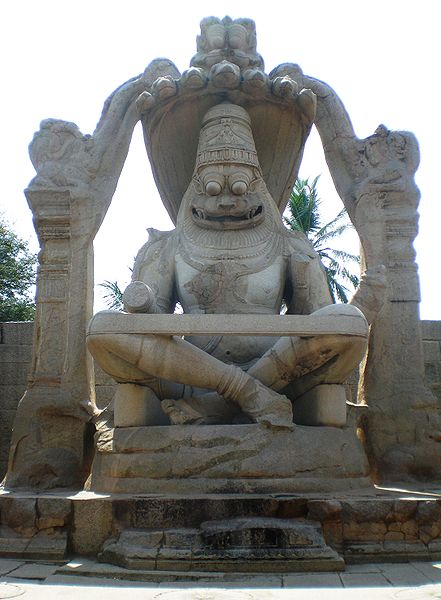
Lion + Man + 7 Snakes
Narasimha, the man-lion incarnation of Vishnu seated on the coils of Śeṣa, with seven heads of Śeṣa forming a canopy. statue at Vijayanagara.
This is the "Thunder Bird" of the Native Northern American traditions.
Thunderbird mythology
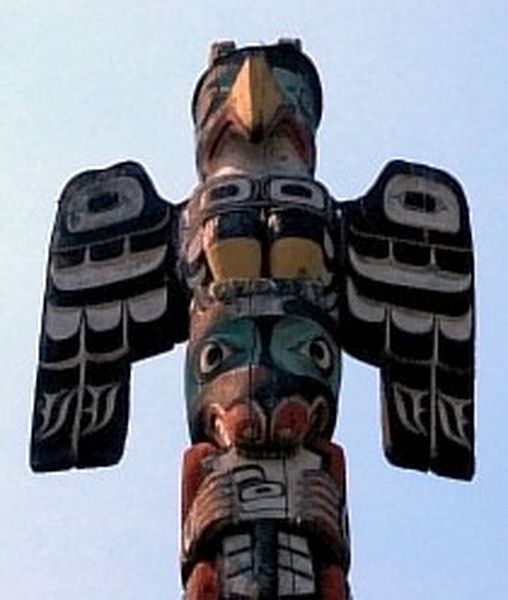
The thunderbird is a legendary creature in certain North American indigenous peoples' history and culture. It is considered a supernatural bird of power and strength. It is especially important, and frequently depicted, in the art, songs and oral histories of many Pacific Northwest Coast cultures, and is found in various forms among the peoples of the American Southwest, Great Lakes, and Great Plains. Thunderbirds were components of the Southeastern Ceremonial Complex of American prehistory.[1][2]
The thunderbird's name comes from the common belief that the beating of its enormous wings causes thunder and stirs the wind. The Lakota name for the thunderbird is Wakį́yą, from wakhą, meaning "sacred", and kįyą, meaning "winged". The Kwakwaka'wakw have many names for the thunderbird, and the Nuu-chah-nulth (Nootka) called it Kw-Uhnx-Wa. The Ojibwa word for a thunderbird that is closely associated with thunder is animikii, while large thunderous birds are known as binesi.
It is described as a large bird larger than both the eagle and the condor, capable of creating storms and thundering while it flies. Clouds are pulled together by its wingbeats, the sound of thunder made by its wings clapping, sheet lightning the light flashing from its eyes when it blinks, and individual lightning bolts made by the glowing snakes that it carries around with it. In masks, it is depicted as multi-colored, with two curling horns, and, often, teeth within its beak. The Native Americans believed that the giant thunderbird could shoot lightning from its eyes.
Carries 2 Snakes, has two curling horns like a Ram, shoots beams of energy from it's eyes?
The Totem represents the Tree/Pole of the Chimera.
Depending on the people telling the story, the thunderbird is either a singular entity or a species. In both cases, it is intelligent, powerful, and wrathful.
The singular thunderbird (as the Nuu-chah-nulth thought of it) was said to reside on the top of a mountain, and was the servant of the Great Spirit. It was also told that the thunderbird controlled rainfall.
It's perched on the highest peaks and brings the rain down, so it's also like Aquarius. The water ram.
It's the servant of the Great Spirit.
The Great Spirit, called Wakan Tanka among the Sioux and Gitche Manitou in Algonquian, is a conception of a supreme being prevalent among some Native American and First Nations cultures. According to Lakotah activist Russell Means a better translation of Wakan Tanka is the Great Mystery.
The Great Spirit or Great Mystery is generally believed to be personal, close to the people, and immanent in the fabric of the material world. Lakotah prayers refer to him as Grandfather; however, not all Nations assign gender, or only one gender, to the Great Mystery. Chief Dan Evehema, a spiritual leader of the Hopi Nation, described the Great Spirit as follows:
"To the Hopi, the Great Spirit is all powerful. He taught us how to live, to worship, where to go and what food to carry, gave us seeds to plant and harvest. He gave us a set of sacred stone tablets into which he breathed all teachings in order to safeguard his land and life. In these stone tablets were inscribed instructions, prophecies and warnings."[citation needed]
"Old Man" is how the Great Spirit is "known" by the Blackfoot people. Old Man personally created all things and personally instructed the Blackfoot people on how to attain spiritual wisdom in daily life:[1]
And when they say "Old Man" isn't like Jesus or Brahmanism, but instead like the Unmoved Mover, Primum Movens it's completely incorrect. They are hoping you are not creative or attentive.
All of these traditions are based on the same concepts, and even relate them in highly similar ways.
Spider Grandmother is the creative agency among the Hopi who personally created the four "colors" of mankind. She attributes to the Sun the power of Creation of all things and origin of all spiritual wisdom and in this way the Sun becomes the living manifestation for the Hopi of the Great Mystery which is personally "known" as Sotuknang:[5]
Spider Grandmother
The Spider Grandmother is creator of the world in Southwestern Native American religions and myths such as that of the Pueblo and Navajo peoples. According to mythology, she was responsible for the stars in the sky, she took a web she had spun, laced it with dew, threw it into the sky and the dew became the stars.
Spider Grandmother, the 'One with Many Arms/Legs/Hands', the 'Great Weaver', the 'Venomous Guardian'. Sound familiar?
What are we talking about here? The 'Great Spirit' and the 'Thunderbird'...
So what does the head of Medusa relate in this context?
Spider Grandmother and the Roc?
Her face/head is the body, and the serpents are the legs.
Kali, Coatlicue, etc.
Her face/head is the Roc, and the serpents are carried by it.
The Head of the Serpent that Devours itself, like the Roc devours Serpents.
That is why they put Wings on Medusa's head, to drive the point home and solidify the connections between all of these icons.
Simurgh
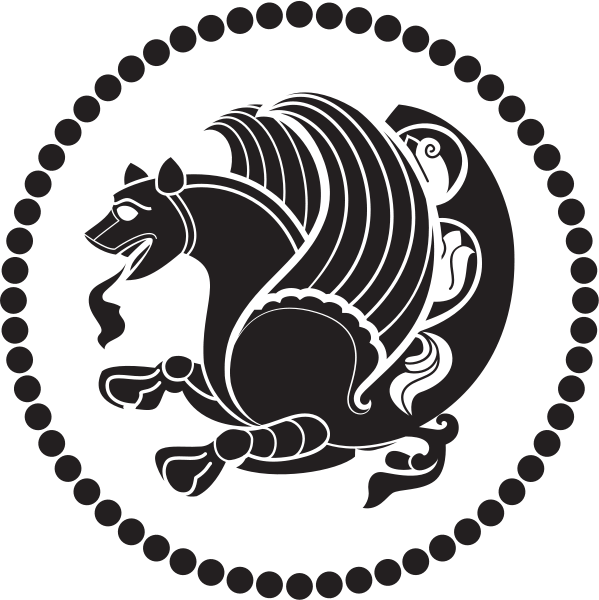

Ok so the Simurgh developed into the Roc, and is associated with the Ghoghnus which links us directly to the Phoenix wiki itself. It Relates this directly to the Date Palm, named scientifically after the Phoenix.
Bird of Paradise, Christianity...etc.
The Fenghuang of China which also links with the hō-ō of Japan.

Simargl of Slavic Myth
With Seven Heads?
Now we are to Griffins
Guardian of the Priceless Treasures.
The Cherub, the Angel, the Harpy, the Sphinx, the Cockatrice, the Roc, the Phoenix.
Even this mere Amusement Park is aware of the Griffin and it's direct association with Gate Keepers.
Very interesting.
Spider Grandmother and the Roc?
Her face/head is the body, and the serpents are the legs.
Kali, Coatlicue, etc.
Her face/head is the Roc, and the serpents are carried by it.
The Head of the Serpent that Devours itself, like the Roc devours Serpents.
That is why they put Wings on Medusa's head, to drive the point home and solidify the connections between all of these icons.
Simurgh
Simurgh (/ˌsɪˈmərɡ/; Persian: سیمرغ), also spelled simorgh, simurg, simoorg or simourv, also known as Angha (Persian: عنقا), is a benevolent, mythical flying creature. The figure can be found in all periods of Greater Iranian art and literature, and is evident also in the iconography of medieval Armenia,[1] the Byzantine empire,[2] and other regions that were within the sphere of Persian cultural influence.[clarification needed] The mythical bird is also found in the mythology of the Turkic peoples of Central Asia and is called Kerkés, Semrug, Semurg, Samran and Samruk.[3][4]


The simurgh is depicted in Iranian art as a winged creature in the shape of a bird, gigantic enough to carry off an elephant or a whale. It appears as a peacock with the head of a dog and the claws of a lion; sometimes however also with a human face.
Iranian legends consider the bird so old that it had seen the destruction of the World three times over. The simurgh learned so much by living so long that it is thought to possess the knowledge of all the Ages. In one legend, the simurgh was said to live 1,700 years before plunging itself into flames (much like the phoenix).
Through cultural assimilation the Simurgh was introduced to the Arabic-speaking world, where the concept was conflated with other Arabic mythical birds such as the Ghoghnus, a bird having some mythical relation with the date palm,[7] and further developed as the Rukh (the origin of the English word "Roc").
Ok so the Simurgh developed into the Roc, and is associated with the Ghoghnus which links us directly to the Phoenix wiki itself. It Relates this directly to the Date Palm, named scientifically after the Phoenix.
In his study of the phoenix, R. van der Broek summarizes, that, in the historical record, the phoenix "could symbolize renewal in general as well as the sun, time, the empire, metempsychosis, consecration, resurrection, life in the heavenly Paradise, Christ, Mary, virginity, the exceptional man, and certain aspects of Christian life".[1]:9
Bird of Paradise, Christianity...etc.
Scholars have observed analogues to the phoenix in a variety of cultures. These analogues include the Persian anka, the Hindu garuda and Gandaberunda, the Russian firebird, the Persian simorgh, the Turkish kerkes, the Tibetan Me byi karmo, the Chinese fenghuang, and the Japanese hō-ō.[3]
The Fenghuang of China which also links with the hō-ō of Japan.
A common depiction of fenghuang was of it attacking snakes with its talons and its wings spread. According to the Erya's chapter 17 Shiniao, fenghuang is made up of the beak of a rooster, the face of a swallow, the forehead of a fowl, the neck of a snake, the breast of a goose, the back of a tortoise, the hindquarters of a stag and the tail of a fish.[1] Today, however, it is often described as a composite of many birds including the head of a golden pheasant, the body of a mandarin duck, the tail of a peacock, the legs of a crane, the mouth of a parrot, and the wings of a swallow.
Its body symbolizes the six celestial bodies. The head is the sky, the eyes are the sun, the back is the moon, the wings are the wind, the feet are the earth, and the tail is the planets. Its feathers contain the five fundamental colors: black, white, red, blue and yellow. It is also sometimes depicted as having three legs.[citation needed] It is believed that phoenix only appear in areas or places that are blessed with utmost peace and prosperity or happiness.
Chinese traditions cites it as living atop the Kunlun Mountains in northern China.

The fenghuang has very positive connotations. It is a symbol of high virtue and grace. The fenghuang also symbolizes the union of yin and yang. Shan Hai Jing's 1st chapter “Nanshang Jing” records each part of fenghuang's body symbolizes a word, the head represents virtue (德), the wing represents duty (義), the back represents propriety (禮), the abdomen says belief (信) and the chest represents mercy (仁).[4]
In ancient and modern Chinese culture, they can often be found in the decorations for weddings or royalty, along with dragons. This is because the Chinese considered the dragon and phoenix symbolic of blissful relations between husband and wife, another common yin and yang metaphor.
Simargl of Slavic Myth
Semargl or Simargl (Old Church Slavonic: Семарьглъ, Симарьглъ) is a deity or mythical creature in East Slavic mythology. An idol of Semargl was present in the pantheon of Great Prince Vladimir I of Kiev. It may be the equivalent of Simurgh in Persian mythology who is also represented like a griffin with a dog body. But according to Vyacheslav Vsevolodovich Ivanov and Vladimir Toporov, the name comes from the Slavonic *Sedmor(o)-golvъ ("with seven heads").[citation needed]
With Seven Heads?
Now we are to Griffins
The griffin, griffon, or gryphon (Greek: γρύφων, grýphōn, or γρύπων, grýpōn, early form γρύψ, grýps; Latin: gryphus) is a legendary creature with the body, tail, and back legs of a lion; the head and wings of an eagle; and an eagle's talons as its front feet. As the lion was traditionally considered the king of the beasts and the eagle was the king of the birds, the griffin was thought to be an especially powerful and majestic creature. The griffin was also thought of as king of the creatures. Griffins are known for guarding treasure and priceless possessions.[1]
Guardian of the Priceless Treasures.
In antiquity it was a symbol of divine power and a guardian of the divine.[3] Some have suggested that the word griffin is cognate with Cherub.[4]
The Cherub, the Angel, the Harpy, the Sphinx, the Cockatrice, the Roc, the Phoenix.
While griffins are most common in the art and lore of Ancient Greece, there is evidence of representations of griffins in Ancient Persian and Ancient Egyptian art as far back as 3,300 BC.[5][6] Most statues have bird-like talons, although in some older illustrations griffins have a lion's forelimbs; they generally have a lion's hindquarters. Its eagle's head is conventionally given prominent ears; these are sometimes described as the lion's ears, but are often elongated (more like a horse's), and are sometimes feathered. The earliest depiction of griffins are the 15th century BC frescoes in the Throne Room of the Bronze Age Palace of Knossos, as restored by Sir Arthur Evans. It continued being a favored decorative theme in Archaic and Classical Greek art.
In 2013, Cedar Point Amusement Park in Sandusky, Ohio opened the "GateKeeper" steel roller coaster which features a griffin as its mascot.
Even this mere Amusement Park is aware of the Griffin and it's direct association with Gate Keepers.
Very interesting.
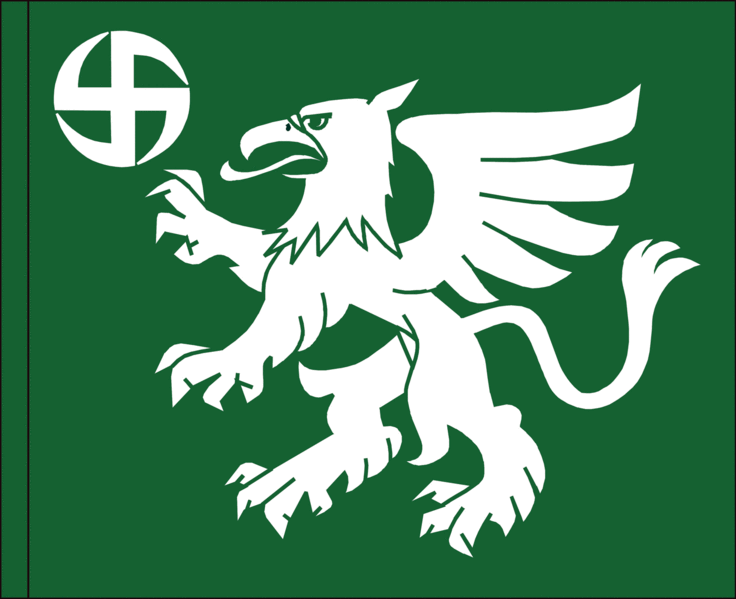
Utti Jaeger Regiment
The Utti Jaeger Regiment (Finnish: Utin Jääkärirykmentti, UtJR) is the Finnish Army training and development centre for special forces and helicopter operations. It consists of about 500 personnel of which about 200 are conscripts.
The colours of the regiment are blazoned Vert, a griffin rampant Argent; in dexter chief a sun-wheel shaped fylfot Argent.
So here we have our Griffin guarding the veiled mystery of the sun-wheel shaped fylfot.
Fylfot
Fylfot or fylfot cross (/ˈfɪlfɒt/ (fil-fot), is a synonym for swastika, sometimes used in Britain.

Arms of Leonard Chamberlayne: Argent a chevron between three fylfots gules – drawn from the blazon given in MS. Harleian, 1394
The Fylfot, together with its sister figure the Gammadion, has been found in a great variety of contexts over the centuries. It has occurred in both secular and sacred contexts in the British Isles, elsewhere in Europe, in Asia Minor[4] and in Africa.[5]
While these two terms might be broadly interchangeable in some places, we can detect a certain degree of affinity between term and terrain. Thus we might usefully associate the Gammadion more with Byzantium, Rome and Graeco-Roman culture on the one hand, and the Fylfot more with Celtic and Anglo-Saxon culture on the other. Although the Gammadion is very similar to the Fylfot in appearance, it is thought to have originated from the conjunction of four capital 'Gammas', Gamma being the third letter of the Greek alphabet.
Both of these swastika-like crosses may have been indigenous to the British Isles before the Roman invasion. Certainly they were in evidence a thousand years earlier but these may have been largely imports.[6] They were certainly substantially in evidence during the Romano-British period with widespread examples of the duplicated Greek fret motif appearing on mosaics.[7] After the withdrawal of the Romans in the early 5th. century there occurred the Anglo-Saxon and Jutish migrations.
Odinic Rite (OR), a Germanic pagan organization, use both "swastika" and "fylfot" for what they claim as a "holy symbol of Odinism". The OR fylfot is depicted with curved outer limbs, more like a "sunwheel swastika" than a traditional (square) swastika or heraldic fylfot.[22]
So it's the symbol of Odin/Tyr/Thor/Donar/etc etc
Odinic Rite
The most commonly cited etymology for this is that it comes from the notion common among nineteenth-century antiquarians, but based on only a single 1500 manuscript, that it was used to fill empty space at the foot of stained-glass windows in medieval churches.
[1] This etymology is often cited in modern dictionaries (such as the Collins English Dictionary and Merriam-Webster OnLine).
Thomas Wilson (1896), suggested other etymologies, now considered untenable:
"In Great Britain the common name given to the Swastika from Anglo-Saxon times ... was Fylfot, said to have been derived from the Anglo-Saxon fower fot, meaning four-footed, or many-footed."
[2] "The word [Fylfot] is Scandinavian and is compounded of Old Norse fiǫl-, equivalent to the Anglo-Saxon fela, German viel, "many", and fótr, "foot", the many-footed figure."[3] The Germanic root fele is cognate with English full, which has the sense of "many". Both fele and full are in turn related to the Greek poly-, all of which stem from the proto-Indo-European root *ple-. A fylfot is thus a "poly-foot", to wit, a "many-footed" sigil.
Which also links us to the Triskelion which is also quite commonplace. Also the Triquetra
Modern Pagans use the triquetra to symbolize a variety of concepts and mythological figures.
Germanic Neopagan groups who use the triquetra to symbolize their faith generally believe it is originally of Norse and Germanic origins.
Due to its presence in insular Celtic art, Celtic Reconstructionist Pagans use the triquetra either to represent one of the various triplicities in their cosmology and theology (such as the tripartite division of the world into the realms of Land, Sea and Sky),[4] or as a symbol of one of the specific triple Goddesses, for example, The Morrígan.
The symbol is also sometimes used by Neo-wiccans and some New Agers to symbolize either the Triple Goddess; or the Three Realms: Earth, sky and sea; or the interconnected parts of our existence (Mind, Body, and Soul).
Also the triquetra is a symbol of protection in the Neo-wiccan religion.[5]
Jainism in India
Sun Cross
In Wicca and other Neopagan religions the sun cross most commonly represents the sun and the four quadrants the wheel of the year, i.e. the four seasonal cycles of the year.
The sun cross has become a widespread symbol of the contemporary Gnostic revival. It is taken after the upper part of the Gnostic cross and the Cathar cross and represents the Pleroma.
What is the Pleroma? Gnosticism
Pleroma (Greek πληρωμα) generally refers to the totality of God's powers. The term means fullness, and is used in Christian theological contexts: both in Gnosticism generally, and in Colossians 2:9.
Gnosticism holds that the world is controlled by evil archons, one of whom is the demiurge, the deity of the Old Testament who holds the human spirit captive.
The heavenly pleroma is the center of divine life, a region of light "above" (the term is not to be understood spatially) our world, occupied by spiritual beings such as aeons (eternal beings) and sometimes archons. Jesus is interpreted as an intermediary aeon who was sent from the pleroma, with whose aid humanity can recover the lost knowledge of the divine origins of humanity. The term is thus a central element of Gnostic cosmology.
Who is the Wheel God Taranis?
And of course it has many common features and so is associated widely:
Also of interest:
Thunder Bird symbolism. Lightning Bolts of Thor's Hammer (Wheel-Cross).
Teshub of the ancient Hurrians.
Tarhun - Hittite , Taru - Hattian
The Wheel God = The Eternal All-God
So it's the Sky-Thunder-Sun and the Earth-Water-Fire-Air, it represents Everything.
Cycles and divisions.
Mjolnir , Thor's Hammer.
Mark of Thor's Hammer. Teshub's Mace/Axe. Lightning Bolts.
So Lightning of the Clouds is intimately related to Light of the Sun. We have a Sun-Thunder deity overlapping here which relates electric to light.
So this means the Sun Wheel is the Thundering Wheel, the T of Time and it's Cycles.
X , Circle X, and T symbols merging.
Tau, Chi, Theta
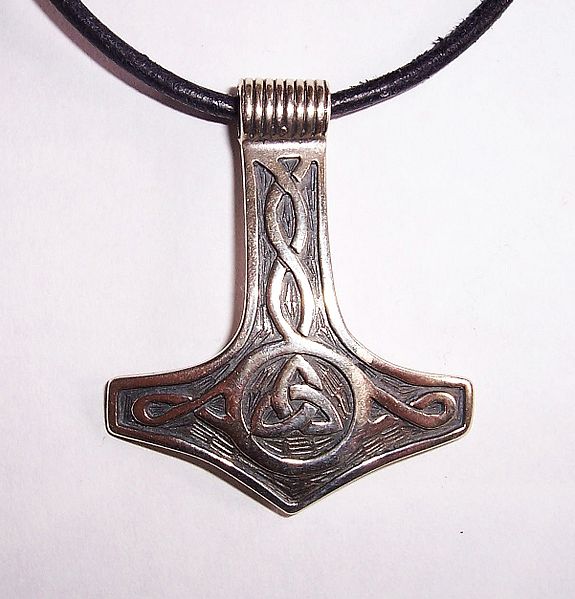
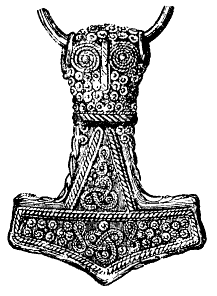
As of a few months ago it is now recognized as a legitimate Grave Headstone.
Also see the Thurmuth Sword as an ancient example, and as an example of how it was damaged suspiciously.
Directly related to Thor's Hammer is Donar's Oak
Yggdrasil
In Celtic mythology Taranis was the god of thunder worshipped essentially in Gaul, Britain and Ireland, but also in the Rhineland and Danube regions, amongst others. Taranis, along with Esus and Toutatis as part of a sacred triad, was mentioned by the Roman poet Lucan in his epic poem Pharsalia as a Celtic deity to whom human sacrificial offerings were made.[1] Taranis was associated, as was the cyclops Brontes ("thunder") in Greek mythology, with the wheel.
And of course it has many common features and so is associated widely:
Many representations of a bearded god with a thunderbolt in one hand and a wheel in the other have been recovered from Gaul, where this deity apparently came to be syncretised with Jupiter.[2]
The name as recorded by Lucan is unattested epigraphically, but variants of the name include the forms Tanarus, Taranucno-, Taranuo-, and Taraino-.[3][4] The name is continued in Irish as Tuireann, and is likely connected with those of Germanic (Norse Thor, Anglo-Saxon Þunor, German Donar) and Sami (Horagalles) gods of thunder. Taranis is likely associated with the Gallic Ambisagrus (likely from Proto-Celtic *ambi-sagros = "about-strength"), and in the interpretatio romana with Jupiter.
Also of interest:
The reconstructed Proto-Celtic form of the name is *Toranos "thunder".[5] In present day Welsh taranu and taran means 'to thunder' and 'thunder' (taraniñ and taran in Breton), and in present day Irish Tarann means 'thunder'. This may also be connected to the Ancient Greek "ουρανός" ("ouranos", meaning "sky"), and "του ουρανού" ("touranou" or "touranos", meaning "of the sky" or "from the sky", possibly indicating the origin of thunder (also see Ogmios).
Taranis, as a personification of thunder, is often identified with similar deities found in other Indo-European pantheons. Of these, Old Norse Þórr, Anglo-Saxon Þunor, Old High German Donar—all from Proto-Germanic *þunraz or *þonar-oz—and the Hittite theonym Tarhun (see Teshub) contain a comparable *torun- element. The Thracian deity names Zbel-thurdos, Zbel-Thiurdos also contain this element (Thracian thurd(a), "push, crash down"). The name of the Sami thunder god Horagalles derives from Thor's.[6][7]
Thunder Bird symbolism. Lightning Bolts of Thor's Hammer (Wheel-Cross).
Teshub of the ancient Hurrians.
Tarhun - Hittite , Taru - Hattian
Teshub is depicted holding a triple thunderbolt and a weapon, usually an axe (often double-headed) or mace. The sacred bull common throughout Anatolia was his signature animal, represented by his horned crown or by his steeds Seri and Hurri, who drew his chariot or carried him on their backs.
The wheel, more specifically the chariot wheel with six or eight spokes, was an important symbol in historical Celtic polytheism, apparently associated with a specific god, known as the wheel-god, identified as the sky- sun- or thunder-god, whose name is attested as Taranis by Lucan.[8] Numerous Celtic coins also depict such a wheel. It is thought to correspond to a sun-cult practiced in Bronze Age Europe, the wheel representing the sun.[who?]
The Wheel God = The Eternal All-God
So it's the Sky-Thunder-Sun and the Earth-Water-Fire-Air, it represents Everything.
Cycles and divisions.
Mjolnir , Thor's Hammer.
According to some scholars, the swastika shape may have been a variant popular in Anglo-Saxon England prior to Christianization, especially in East Anglia and Kent.[12] Wilson (1894) points out that while the swastika had been "vulgarly called in Scandinavia the hammer of Thor" ( in Icelandic: Thorshamarmerki, mark of Thor's hammer ) , the symbol properly so called had a Y or T shape.[13]
Mark of Thor's Hammer. Teshub's Mace/Axe. Lightning Bolts.
The Gammadion or rather the tetra-gammadion is a swastika. Although the swastika had been used as a symbol of Nazi Germany and the Nazi Party, it also is being used by Buddhist Associations and even alchemists. It symbolises the four cardinal corners of this world and the guardianship of this world in traditional alchemy.
So Lightning of the Clouds is intimately related to Light of the Sun. We have a Sun-Thunder deity overlapping here which relates electric to light.
So this means the Sun Wheel is the Thundering Wheel, the T of Time and it's Cycles.
X , Circle X, and T symbols merging.
Tau, Chi, Theta

A modern Mjöllnir pendant.

Drawing of a Viking Age gold-plated silver Mjölnir pendant (length 4.6 cm) found at Bredsätra in Öland, Sweden, now kept in the Swedish Museum of National Antiquities.
In May 2013 the "Hammer of Thor" was added to the list of United States Department of Veterans Affairs emblems for headstones and markers.
As of a few months ago it is now recognized as a legitimate Grave Headstone.
Also see the Thurmuth Sword as an ancient example, and as an example of how it was damaged suspiciously.
Directly related to Thor's Hammer is Donar's Oak
Jove's Oak (interpretatio romana for Donar's Oak and therefore sometimes referred to as Thor's Oak) was a sacred tree of the Germanic pagans
Sacred trees and sacred groves were widely venerated by the Germanic peoples and scholars have linked this oak and others to the world tree in Norse mythology, Yggdrasil.
Veneration of sacred groves and sacred trees is found throughout the history of the Germanic peoples and were targeted for destruction by Christian missionaries during the Christianization of the Germanic peoples. Ken Dowden notes that behind this great oak dedicated to Donar, the Irminsul (also felled by Christian missionaries in the 8th century), and the Sacred tree at Uppsala (described by Adam of Bremen in the 11th century), stands a mythic prototype of an immense world tree, described in Norse mythology as Yggdrasil.[5]
Yggdrasil
edit on 10-9-2013 by muzzleflash because: (no reason given)
Ok so when you look at Thor's Hammer, think of the Caduceus.
The Chi the Tao and the Theta.
When you see the Sun-Wheel, Swastika, Fylfot, whatever:
Think of the Four Directions, the Four Elements, the Four Faced One - Rotating.
Think about "Squaring the Circle" in association with this symbolism.
The Middle, the Center of it is the Meso, the I, where all occult symbolism reveals the true nature of God is hidden within the inner Abyss guarded by one's own self from one's self.
Look into the traditions of masks and hats, what they represent and their functions.
Carvings and statuary of Heads or Faces worldwide, and questioning what does it mean?
Ask why in Polynesian culture we have stories like :
Kane and Kanaloa?
Kan/Can = Serpent
Loa = Spirit in Voodoo
How is this possible?
Red Earth + Saliva ? Red + White
Hieros Gamos...
Woman made from the Rib...
First murder story....
"Ivi" is the first wife? Eve...
Stares into the pool's reflection longing for a lover.
Cosmic foam, out pops the woman.
The Eel connected Tiki and the Woman into the act of procreation.
Tiki
So again we have the Deity Icon being used as a Guardian of Boundaries.
Taking us back to the typical global Head motif and giving us common themes to work with.
Tiki masks
Masks are similar to hoods in that they veil the wearer's true nature.
Tiki Mask = GodHood = GodHead = the Gate Keeper
Mythic Hawaii
Google variations of things like "Tiki Statues, Masks" etc. Possibly also add in names of specific deities and other terms to weed out all of the merchandise websites with newer less artistic pieces.
4 'uncreated' Gods = Thundering Wheel = Four Faced One
Again the deeper mysteries of culture seem to be laying right on the surface just waiting for someone to notice.
The Chi the Tao and the Theta.
When you see the Sun-Wheel, Swastika, Fylfot, whatever:
Think of the Four Directions, the Four Elements, the Four Faced One - Rotating.
Think about "Squaring the Circle" in association with this symbolism.
The Middle, the Center of it is the Meso, the I, where all occult symbolism reveals the true nature of God is hidden within the inner Abyss guarded by one's own self from one's self.
Look into the traditions of masks and hats, what they represent and their functions.
Carvings and statuary of Heads or Faces worldwide, and questioning what does it mean?
Ask why in Polynesian culture we have stories like :
In Hawaiian traditions the first man was Kumuhonua. He was made by Kāne, or by Kāne, Kū, and Lono. His body was made by mixing red earth with saliva. He was made in the shape of Kāne, who carried the earth from which the man was made from the four corners of the world. A woman was made from one of his ribs. Kanaloa was watching when Kāne made the first man, and he too made a man, but could not bring him to life. Kanaloa then said to Kāne, “I will take your man, and he will die.” And so death came upon mankind (Tregear 1891:151).
In Tahiti, Tiʻi was the first man, and was made from red earth. The first woman was Ivi who was made from one of the bones (ivi) of Tiʻi (Tregear 1891:151) .
Kane and Kanaloa?
Kan/Can = Serpent
Loa = Spirit in Voodoo
How is this possible?
Red Earth + Saliva ? Red + White
Hieros Gamos...
Woman made from the Rib...
First murder story....
"Ivi" is the first wife? Eve...
In traditions from the East Coast of the North Island of New Zealand, the first human is a woman created by Tāne, god of forests and of birds. Usually her name is Hine-ahu-one. In other legends, Tāne makes the first man Tiki, then makes a wife for him. In some West Coast versions, Tiki himself, as a son of Rangi and Papa, creates the first human by mixing his own blood with clay, and Tāne then makes the first woman. Sometimes Tūmatauenga, the war god, creates Tiki.[1] In another story the first woman is Mārikoriko. Tiki marries her and their daughter is Hine-kau-ataata (White 1887-1891, I:151-152). [2] In some traditions, Tiki is the penis of Tāne (Orbell 1998:178, Tregear 1891:510-511). In fact, Tiki is strongly associated with the origin of the procreative act.[3]
Here is one story of Tiki among the many variants: Tiki was lonely and craved company. One day, seeing his reflection in a pool, he thought he had found a companion, and dived into the pool to seize it. The image shattered and Tiki was disappointed. He fell asleep and when he awoke he saw the reflection again. He covered the pool with earth and it gave birth to a woman. Tiki lived with her in innocence, until one day the woman was excited by an eel. Her excitement passed to Tiki and the first procreative act resulted (Reed 1963:52).
Stares into the pool's reflection longing for a lover.
Cosmic foam, out pops the woman.
The Eel connected Tiki and the Woman into the act of procreation.
Tiki refers to large wood and stone carvings of humanoid forms in Central Eastern Polynesian cultures of the Pacific Ocean. The term is also used in Māori mythology where Tiki is the first man, created by either Tūmatauenga or Tāne. He found the first woman, Marikoriko, in a pond – she seduced him and he became the father of Hine-kau-ataata. In the Māori language, the word "tiki" was the name given to large wooden carvings in roughly human shape, although this is a somewhat archaic usage. The carvings often serve to mark the boundaries of sacred or significant sites.
Tiki
So again we have the Deity Icon being used as a Guardian of Boundaries.
Taking us back to the typical global Head motif and giving us common themes to work with.
These masks are significant because they pay homage to an ancient Polynesian god, Tiki, who was considered by many as the first man. Moreover, the symbolic nature of wearing these masks or erecting Tiki poles is designed to capture the power of Tiki. Tiki statues are designed to protect or secure the boundaries of a tribe and these masks were designed to capture the power of the ancient Polynesian god Tiki.
Tiki masks
Masks are similar to hoods in that they veil the wearer's true nature.
Tiki Mask = GodHood = GodHead = the Gate Keeper
Mythic Hawaii
Google variations of things like "Tiki Statues, Masks" etc. Possibly also add in names of specific deities and other terms to weed out all of the merchandise websites with newer less artistic pieces.
Ku – Ancient Tiki God of War
In Hawaiian mythology Ku is one of the four great gods along with the ancient tiki gods, Kanaloa, Kane, and Lono. He was the husband of the goddess Hina (Beckwith 1970:12), suggesting a complementary dualism as the word ku in the Hawaiian language means "standing up" while one meaning of 'hina' is 'fallen down.'
Ku is worshipped under many names, including Ku-ka-ili-moku, the "Seizer of Land" (a feather-god, the guardian of Kamehameha). Rituals included human sacrifice, which was not part of the worship of the other gods. Ku, Kane, and Lono caused light to shine in upon the world. They are uncreated gods who have existed from eternity (Tregear 1891:540).
4 'uncreated' Gods = Thundering Wheel = Four Faced One
Lono – Ancient Tiki God of Fertility and Peace
Kane– Ancient Tiki God of Light and Life
In Hawaiian mythology, Kane Milohai is the father of the tiki gods Ka-moho-ali'i, Pele (whom he exiled to Hawaii), Kapo, Namaka and Hi'iaka by Haumea. He created the sky, earth and upper heaven and gave Kumu-Honua the garden. He owned a tiny seashell that, when placed on the ocean's waves, turned into a huge sailboat. The user of the boat had merely to state his destination and the boat took him there. In agricultural and planting traditions, Kane was identified with the sun.
The word Kane alone means "man". As a creative force, Kane was the heavenly father of all men. As he was the father of all living things, he was a symbol of life in nature.
In many chants and legends of Ancient Hawaii, Kane is paired with the god Kanaloa, and is considered one of the four great Hawaiian divinities along with Kanaloa, Ku, and Lono.
Alternatively known as Kane, Kane-Hekili ("thunderer" or "lightning breaking through the sky"), Kane Hoalani.
Kanaloa – Ancient Tiki God the Sea
For example: Kane was called upon during the building of a canoe, Kanaloa during the sailing of it; Kane governed the northern edge of the ecliptic, Kanaloa the southern; Kanaloa points to hidden springs, and Kane then taps them out. In this way, they represent a divine duality of wild and taming forces like those observed (by Georges Dumezil, et al.) in Indo-European chief god-pairs like Odin-Tyr and Mitra-Varuna, and like the popular yin-yang of Chinese Taoism.
Again the deeper mysteries of culture seem to be laying right on the surface just waiting for someone to notice.
edit on 11-9-2013 by
muzzleflash because: (no reason given)
edit on 11-9-2013 by muzzleflash because: (no reason given)
edit on 11-9-2013
by muzzleflash because: (no reason given)
Will make a post about this symbol, Ouroboros, and share a discovery I made yesterday at complete random while looking up etymology and history of
star names...

And of course "Boros" = Devour / Eat
So instead of Tail, we alternatively have "Watchman" or "Guardian"
Guard + Eat = Guardian of Eating = Garden of Eden
This symbolism goes back to the furthest depths of antiquity.
This website lists some esoteric meanings
Side info :
Wiki
It's the symbolism of the Abyss Entrance, the O from which All came.
The head of Medusa, or even similar to that of Coatlicue or other symbolism I will discuss further.
The legs tell you about the "4" aspect.
The head of Medusa is this essentially :

Again you have the 4 Elements/Faces surrounding the central Medusa (villain at center of Labyrinth within self). Surrounding this are the 8 reminding you this is also Spider Grandmother.
AKA Saturn-Cronus Father Time the Grim Reaper.
The Calendar symbolism.
Guardian of Time Cycles.
Here is a link that appears to explain how the double wheel calendar system worked in simple terminology.
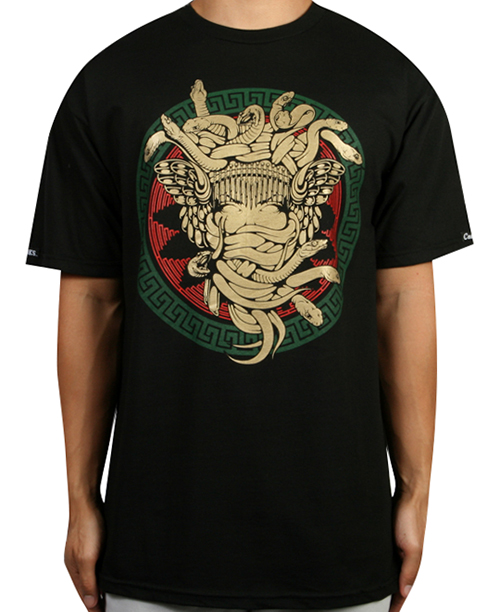
A clue from a Brand Named "Crooks and Castles".
That shirt is called "MAYAN BIRD".

Same brand company, this one is pretty obvious if you have been following along.
Link to their website
Ok so Mayan Bird = Feathered Serpent = Medusa the Abyss = God Head
On an additional note::
Sun-Wheel shaped Fylfot = 4 Sickles/Bolts of the Wheel of Time/Eternal Harvest
All Sun-wheels or swastikas can also indicate:
Swirling Churning of the Creation
The Pearl coming out of the Bivalve.

warrant (n.)
early 13c., "protector, defender," from Old North French warant (Old French garant),
from Frankish *warand (cf. Old High German weren "to authorize, warrant," German gewähren "to grant"),
from Proto-Germanic *war- "to warn, guard, protect," perhaps from PIE root *wer- "to cover"
(cf. Latin vereri "to observe with awe, revere, respect, fear;" Greek ouros "watchman," horan "to see;"
Hittite werite- "to see;" see weir).
And of course "Boros" = Devour / Eat
So instead of Tail, we alternatively have "Watchman" or "Guardian"
Guard + Eat = Guardian of Eating = Garden of Eden
This symbolism goes back to the furthest depths of antiquity.
This website lists some esoteric meanings
Egyptian: Symbolic of the sun – it’s rising and setting signifying the cycle of the day
Gnostic: Oneness of all life, the constant process of re-recreation and the unity behind all duality
Roman: Eternity, time and associated with Janus the god of the new year
Greece: Death and rebirth as illustrated in the Orphic creation myth – another reference to the cosmic egg symbolism
African: Here it is known as the “rainbow serpent” or Aido Hwedo and is an emblem of sustaining life, protection and creation
Side info :
In Vodou, especially in Benin and Haiti, Ayida-Weddo is a loa of fertility, rainbows, wind, water, fire, and snakes.[1] Ayida-Weddo is known as the Rainbow Serpent.
Wiki
The serpent (or pair of serpents) with tail in mouth communicates self-sufficiency: The creature begets, weds, impregnates, and slays itself with a power that continually consumes and renews. In every end is a new beginning. In some funerary art the ouroboros represents immortality, eternity, and wisdom.
Cycles
Eternity
Rebirth
Potential
Perpetuity
Actualization
The alchemists illustrate this serpent wrapped around the cosmic egg, signifying the life span of the universe. Furthermore, the center opening shown in typical uroboros illustrations may also symbolize the egg which speaks of :
Inceptions
Beginnings
Openings
Latent power
Limitless potential
It's the symbolism of the Abyss Entrance, the O from which All came.
The head of Medusa, or even similar to that of Coatlicue or other symbolism I will discuss further.
The legs tell you about the "4" aspect.
The head of Medusa is this essentially :

Again you have the 4 Elements/Faces surrounding the central Medusa (villain at center of Labyrinth within self). Surrounding this are the 8 reminding you this is also Spider Grandmother.
AKA Saturn-Cronus Father Time the Grim Reaper.
The Calendar symbolism.
Guardian of Time Cycles.
Here is a link that appears to explain how the double wheel calendar system worked in simple terminology.

A clue from a Brand Named "Crooks and Castles".
That shirt is called "MAYAN BIRD".

Same brand company, this one is pretty obvious if you have been following along.
Link to their website
Ok so Mayan Bird = Feathered Serpent = Medusa the Abyss = God Head
On an additional note::
Sun-Wheel shaped Fylfot = 4 Sickles/Bolts of the Wheel of Time/Eternal Harvest
All Sun-wheels or swastikas can also indicate:
Swirling Churning of the Creation
The Pearl coming out of the Bivalve.
As you can probably tell my thinking/though processes evolve and fluctuate over time, so forgive my drifting nature.
Ok so I told you Angels were Harpies well, their Halo symbol is the Ouroboros.
What is that telling us? Abyss Guardian.

So what is this telling us in this deeper context?
Again, Vulture + Snake = Feathered Serpent
Guardian of Abyss Within
The Eye = Medusa / Carp / Fish Sign / Leviathan

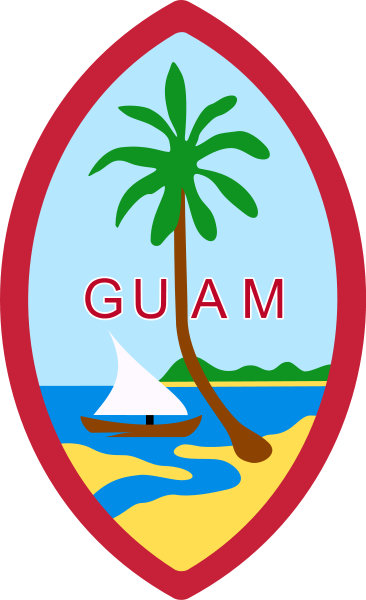

Now check this out::

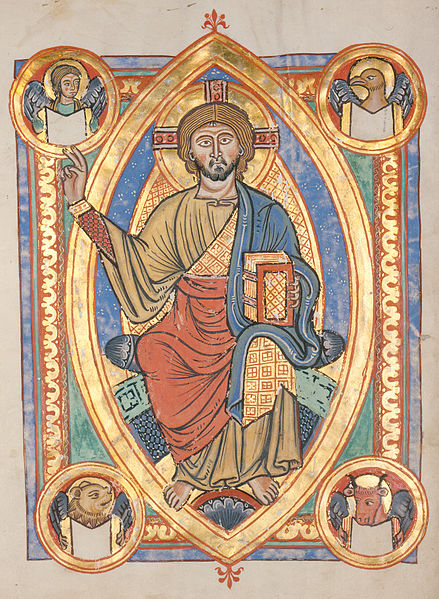
Vesica Piscis
Christ in Majesty
Again, 4 faces of the Chimera/Cherub.
The Burning Bush, that Palm Tree.
Enter the Carp, the so called "Jesus Fish".
Ok so I told you Angels were Harpies well, their Halo symbol is the Ouroboros.
What is that telling us? Abyss Guardian.

So what is this telling us in this deeper context?
Again, Vulture + Snake = Feathered Serpent
Guardian of Abyss Within
The Eye = Medusa / Carp / Fish Sign / Leviathan

Coat of arms of Braslaw, Belarus.

Coat of arms of Guam

Church of Scotland logo
Now check this out::

Christ in majesty within a mandorla-shaped aureola, surrounded by emblems of the evangelists (13th century)

Christ in Majesty within a mandorla-shaped aureola in a medieval illuminated manuscript
Vesica Piscis
Christ in Majesty
Again, 4 faces of the Chimera/Cherub.
The Burning Bush, that Palm Tree.
Enter the Carp, the so called "Jesus Fish".
reply to post by muzzleflash
I like that people have worked it out. S&F.
There's still a missing piece, or is it simply hidden somewhere in plain sight?
I like that people have worked it out. S&F.
There's still a missing piece, or is it simply hidden somewhere in plain sight?
My my, thats a lot of word-porn.
Lets just ignore the etymology of words though, because then it works.
Lets just ignore the etymology of words though, because then it works.
edit on 13-9-2013 by Tidnabnilims because: incorrect negative in
context
The "Pearl" inside the "Bivalve".
Pearl Wiki
Ok so we have Pearl symbolism in cultures worldwide through history for many obvious reasons.
Ok so Vishnu has a Pearl on his Chest, and the New Jerusalem is enclosed by "12 Pearled Gates".
The "Pearl of God" is the "Pearl of Great Price".
Pearl = Spirit / Soul / Silver / Iridescence / Rainbow Colors / Transition
Hymn of the Pearl
Pearl of Great Price
Streets of "Transparent Gold" in New Jerusalem = Rays of Light Amber
Amber and Pearl
Amber comes from trees, and in this example it notes the Poplar Tree which is also rather interesting.
Let's hop over to Aquamarine (Gem) briefly for some strange etymology.
Marina = Marine = Sea / Ocean
Marine is Mari-Mary-Ari
Now check this out:::
Female Horse...?
Mari, March, and Morrigain??
Hippocamp
Seahorse
So who is the AquaMarine?

Denver Airport Blue Bronco Arising
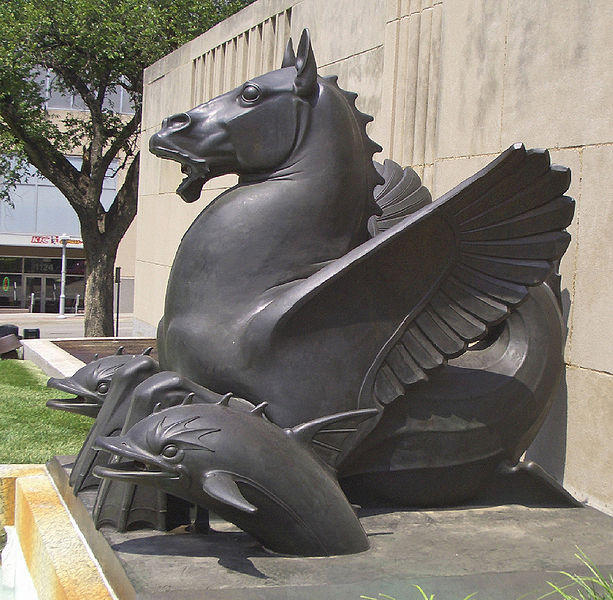
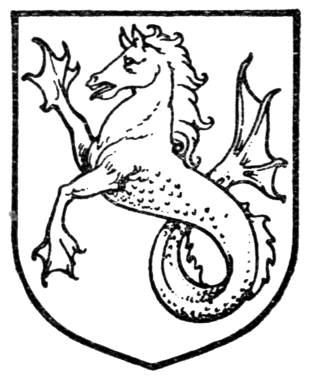
The Aqua Mare - Water Horse
It's name and color is that of water.
Poseidon. Recall the Golden Fleece ?
Thus Capricorn, the Water-Goat/Ram.
Pearl Wiki
Ok so we have Pearl symbolism in cultures worldwide through history for many obvious reasons.
The most famous being the Koustubha which Lord Vishnu wears on his chest.
In a Christian New Testament parable, Jesus compared the Kingdom of Heaven to a "pearl of great price" in Matthew 13: 45–46. "Again, the kingdom of heaven is like unto a merchant man, seeking goodly (fine) pearls: Who, when he had found one pearl of great price, went and sold all that he had, and bought it."
The twelve gates of the New Jerusalem are reportedly each made of a single pearl in Revelation 21:21, that is, the Pearly Gates. "And the twelve gates were twelve pearls; every gate was of one pearl: and the streets of the city were pure gold, as if transparent glass."
Ok so Vishnu has a Pearl on his Chest, and the New Jerusalem is enclosed by "12 Pearled Gates".
The "Pearl of God" is the "Pearl of Great Price".
Pearl = Spirit / Soul / Silver / Iridescence / Rainbow Colors / Transition
The Qur'an often mentions that dwellers of paradise will be adorned with pearls:
The metaphor of a pearl appears in the longer Hymn of the Pearl, a poem respected for its high literary quality, and use of layered theological metaphor, found within one of the texts of Gnosticism.
The Pearl of Great Price is a book of scripture in The Church of Jesus Christ of Latter-day Saints.
Hymn of the Pearl
Pearl of Great Price
Streets of "Transparent Gold" in New Jerusalem = Rays of Light Amber
The classical name for amber was electrum (ἤλεκτρον ēlektron), connected to a term for the "beaming Sun", ἠλέκτωρ (ēlektōr).[7][8] According to the myth, when Phaëton son of Helios (the Sun) was killed, his mourning sisters became poplars, and their tears became the origin of elektron, amber.[9]
Amber and Pearl
Amber comes from trees, and in this example it notes the Poplar Tree which is also rather interesting.
Poplar was the most common wood used in Italy for panel paintings; the Mona Lisa and most famous early renaissance Italian paintings are on poplar. The wood is generally white, often with a slightly yellowish colour.
Some stringed instruments are made with one-piece poplar backs;
Let's hop over to Aquamarine (Gem) briefly for some strange etymology.
Aquamarine (from Latin: aqua marina, "water of the sea")
Marina = Marine = Sea / Ocean
Marine is Mari-Mary-Ari
marine (adj.)
early 15c., "pertaining to the sea," from Middle French marin, from Old French marin "of the sea, maritime," from Latin marinus "of the sea," from mare "sea, the sea, seawater," from PIE *mori- "body of water, lake" (see mere (n.)). The Old English word was sælic.
mere (n.)
Old English mere "sea, ocean; lake, pool, pond, cistern," from Proto-Germanic *mari (cf. Old Norse marr, Old Saxon meri "sea," Middle Dutch maer, Dutch meer "lake, sea, pool," Old High German mari, German Meer "sea," Gothic marei "sea," mari-saiws "lake"), from PIE *mori- "sea" (cf. Latin mare, Old Church Slavonic morje, Russian more, Lithuanian mares, Old Irish muir, Welsh mor "sea," Gaulish Are-morici "people living near the sea").
mare (n.2)
"broad, dark areas of the moon," 1765, from Latin mare "sea" (see marine), applied to lunar features by Galileo and used thus in 17c. Latin works. They originally were thought to be actual seas.
Now check this out:::
mare (n.1)
"female horse," Old English mere (Mercian), myre (West Saxon), fem. of mearh "horse," from Proto-Germanic *markhjon- (cf. Old Saxon meriha, Old Norse merr, Old Frisian merrie, Dutch merrie, Old High German meriha, German Mähre "mare"), said to be of Gaulish origin (cf. Irish and Gaelic marc, Welsh march, Breton marh "horse").
Female Horse...?
mare (n.3)
"night-goblin, incubus," Old English mare "incubus, nightmare, monster," from mera, mære, from Proto-Germanic *maron "goblin" (cf. Middle Low German mar, Middle Dutch mare, Old High German mara, German Mahr "incubus," Old Norse mara "nightmare, incubus"), from PIE *mora- "incubus" (cf. first element in Old Irish Morrigain "demoness of the corpses," literally "queen of the nightmare," also Bulgarian, Serbian mora, Czech mura, Polish zmora "incubus;" French cauchemar, with first element from Old French caucher "to trample"), from root *mer- "to rub away, harm"
Mari, March, and Morrigain??
Hippocamp
Seahorse
So who is the AquaMarine?

Denver Airport Blue Bronco Arising

Winged Hippocamp in an Art Deco fountain, Kansas City, Missouri, (1937)

The "sea-horse" in medieval heraldry
The Aqua Mare - Water Horse
It's name and color is that of water.
Poseidon. Recall the Golden Fleece ?
Thus Capricorn, the Water-Goat/Ram.
edit on 13-9-2013 by muzzleflash because: (no reason given)
edit on 13-9-2013 by
muzzleflash because: (no reason given)
Polaris (n.)
1769, short for stella polaris, Modern Latin, literally "the pole star" (see polar). The ancient Greeks called it Phoenice, "the Phoenician (star)," because the Phoenicians used it for navigation, though due to precession of the equinoxes it was not then the pole star. Also see pole (n.2). The Old English word for it was Scip-steorra "ship-star," reflecting its importance in navigation. As the name of a U.S. Navy long-range submarine-launched guided nuclear missile, it dates from 1957.
North Star
"Pole Star, Polaris," Middle English norþe sterre (late 14c.); cf. Middle Dutch noirdstern, German nordstern.
Ok so Polaris = Pole Ariser - Polarizer
"The Phoenician(Phoenix)"
North Star = Norse Star
Aries Look up Aries at Dictionary.com
zodiac constellation usually identified as "the Ram," late Old English, from Latin aires "ram" (cf. arietare "to butt"), from a PIE root meaning "spring, jump" (cf. Lithuanian erytis, Old Church Slavonic jarici, Armenian oroj "lamb;" Greek eriphos, Old Irish heirp "kid").
Ok so follow the connections :::
Aries PIE root - "Jump" - means "Arise" thus
Flying Ram - Celestial Sea Ram - Water Ram - Capricorn
Old Irish heirp "kid" - Heirp Harp - Messenger Child Ram Kid no kidding.
Another interesting bizarre "coincidence" :
harp (n.)
Old English hearpe, from Proto-Germanic *kharpon- (cf. Old Saxon harpa "instrument of torture;" Old Norse harpa, Dutch harp, Old High German harpfa, German Harfe "harp").
Kharpon? Carp!!
Instrument of Torture?
carp (v.)
"complain," early 13c., originally "to talk," from Old Norse karpa "to brag," of unknown origin; meaning turned toward "find fault with" (late 14c.), probably by influence of Latin carpere "to slander, revile," literally "to pluck"
Carp = Talk - Brag - Slander - Pluck
So the Harpy's Carp is like torture.
And it plucks strings of the harp like you pluck the feathers.
Carp and Harp are directly connected once you dig through all of these pathways.
Not to mention they are only one letter different, which was connected through the -KH.
Now let's investigate another route from "Heirp":
here
Old English her "in this place, where one puts himself," from Proto-Germanic pronomial stem *hi- (from PIE *ki- "this;" see he)
+ adverbial suffix -r. Cognate with Old Saxon her, Old Norse, Gothic her, Swedish här,
Middle Dutch, Dutch hier, Old High German hiar, German hier.
KI = Hi = He = Her = Here
The "QI" is "Right Here"
You "Hear the Harp-Harpy"
Your "Ear is the Key".
Q I = 0 + 1
5 Aspects of Temple of QI *Your Body*
Sight Sound Touch Taste Smell
Thus Pole Star POLARIS = AXIS MUNDI through etymological meanings.
Thus we have IRAN, Aryan, which come from Aries.
Now you know a lot more about why the Nazis were so interested in "Aryans" and "Ancient Mystical Knowledge". There is a lot more to that though of course.
Ok so what is the legend of Bloody Mary in the mirror about?
Hecate , Medusa, etc.
Tons of variations on this type of legend, including Candy Man (Film) whose symbolism includes the Eye, the Hook-Reaper, and the Bees.
This is similar to Hanako-san of Japan.
In one variation :
Three being a important number for the "Bathroom Demon" and it's summoning.
Cerberus the three-headed Hell hound, the guardian.
Some more links/pics of Guardian motifs that I meant to link earlier but didn't get around to yet:::
Snow Lion

East (Rising), Mountains/Earth motif. Neuter Gender.
And now check this out:
Gankyil

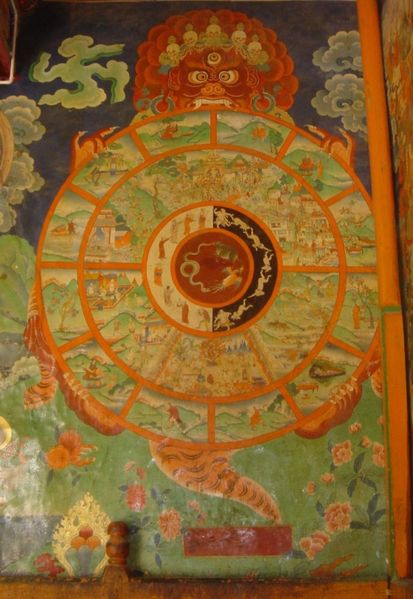
Look familiar?
Tons of info on that very interesting link.
Three Jewels
Also note the Snow Lion has a extremely loud Roar just as would be expected.
Historically, the ritual encouraged young women to walk up a flight of stairs backwards while holding a candle and a hand mirror, in a darkened house. As they gazed into the mirror, they were supposed to be able to catch a view of their future husband's face.[1] There was, however, a chance that they would see a skull (or the face of the Grim Reaper) instead, indicating that they were destined to die before they married.[1][2]
A modern ritual addition of taunting Bloody Mary regarding her baby indicates the legendary figure's tenuous connection to Queen Mary I, also known as "Bloody Mary", whose life was marked by a number of miscarriages or false pregnancies.[3]
Bloody Mary allegedly appears as a corpse, a witch or a ghost; sometimes covered in blood. The lore surrounding the ritual (if she is summoned properly) states that participants may endure the apparition screaming at them, cursing them, strangling them, stealing their body or soul, drinking their blood,[4] or scratching their eyes out.[5]
Hecate , Medusa, etc.
Tons of variations on this type of legend, including Candy Man (Film) whose symbolism includes the Eye, the Hook-Reaper, and the Bees.
This is similar to Hanako-san of Japan.
In one variation :
After Hanako-san has answered and one enters the stall, he or she will find and be eaten by a three headed lizard who had mimicked a girl's voice
Three being a important number for the "Bathroom Demon" and it's summoning.
Cerberus the three-headed Hell hound, the guardian.
Some more links/pics of Guardian motifs that I meant to link earlier but didn't get around to yet:::
Snow Lion
a celestial animal of Tibet. It symbolizes fearlessness, unconditional cheerfulness, east and the earth element. It is one of the Four Dignities. It ranges over the mountains, and is commonly pictured as being white with a turquoise mane.

East (Rising), Mountains/Earth motif. Neuter Gender.
The Lion is a sacred and regal symbol in many ancient cultures from Egypt to the Greek and Roman Empires and further east to Persia and ultimately to India in the second century. In Buddhism the Snow Lion is the protector of Buddha and in paintings and sculpture is usually seen as holding up the Buddha's throne (one on the left and one on the right of the throne.) The body of the Snow Lion is white while its flowing hair of mane, tail and curls on legs, is either blue or green. While most Snow Lions are gender neutral in Buddhist art there are some that are represented as obviously male and some as obviously female. When represented as a symmetrical pair the male is on the left and the female on the right.
And now check this out:
The Snow Lion is an archetypal thoughtform confluence or personification of the primordial playfullness of 'joy' and 'bliss' (Sanskrit: ananda; Tibetan: dga' ), somewhat energetically comparable to the western unicorn, though without a horn. Though paradoxical, the Snow Lion does not fly but their feet never touch the ground; their existence is a playful 'continuum' (Tibetan: rgyud) of leaping from mountain peak to mountain peak. The energetic potency (wisdom or shakti) of the Snow Lion is expressed in the attribute of the gankyil/gakyil ('bliss+whirling' or 'wheel of joy') that the Snow Lion keep in eternal play. The gankyil is a vriddhi derivation of the dragon's fiery 'pearl of great price'.[2]
Gankyil


Look familiar?
Gankyil དགའ་འཁྱིལ (Wylie: dga'_'khyil),[3] (equivalent Sanskrit: ananda-chakra), pronounced "ganshey" or "ganshee", is formed from the words dga' ("joy, elation, rapture, bliss, ecstasy, beauty, total happiness" i.e. the opposite of dukkha) and 'khyil ("swirling; circle, ring, bracelet, coil,mandala, a place where water flows"). Thus, it may be rendered into English as "bliss-whirling" or "wheel of joy".
The wheel of joy is commonly depicted at the central hub of the dharmachakra, where its three or four swirls may represent the Three Jewels and victory over the three poisons, or the Four Noble Truths and the four directions. As a symbol of the Three Jewels it may also appear as the 'triple-eyed' or wish-granting gem of the chakravartin. In the Dzogchen tradition the three swirls of the gakyil primarily symbolize the trinity of the base, path, and fruit.
Tons of info on that very interesting link.
The Triple Gem is in the center of one of the major practices of mental "reflection" in Buddhism; the reflection on the true qualities of the Buddha, Dharma and Sangha. These qualities are called the Mirror of the Dharma in the Mahaparinibbana Sutta and help the practitioner attain the true "mind like a mirror".
Three Jewels
Also note the Snow Lion has a extremely loud Roar just as would be expected.
Also of note is Ziz the giant Griffon.
Also there is the Sharabha

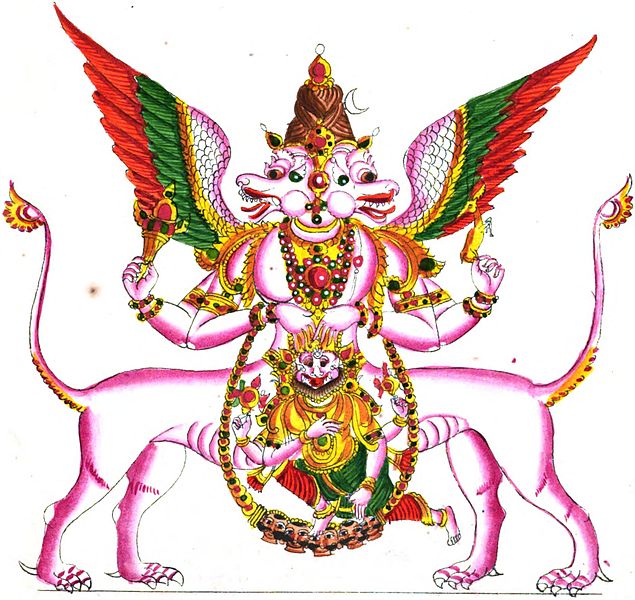
Which goes along with Gandaberunda.


Which is essentially the Double Headed Eagle in European Heraldry.
The Ziz (Hebrew: זיז) is a giant griffin-like bird in Jewish mythology, said to be large enough to be able to block out the sun with its wingspan. It is considered a giant animal/monster corresponding to archetypal creatures. Rabbis have said that the Ziz is comparable to the Persian Simurgh, while modern scholars compare the Ziz to the Sumerian Anzu and the Ancient Greek phoenix.[1] Behemoth, Leviathan and Ziz were traditionally a favorite decoration motif for rabbis living in Germany.
Also there is the Sharabha
Sharabha (Sanskrit: शरभ, Śarabha) is a creature in Hindu mythology that is part lion and part bird. According to Sanskrit literature, Sharabha is an eight-legged beast, mightier than a lion and elephant and which can kill the lion. Sharabha, can clear a valley in one jump. In later literature, Sharabha is described as an eight-legged deer.[1][2]
Shaiva scriptures narrate that god Shiva assumed the Avatar (incarnation) of Sharabha to tame Narasimha - the fierce man-lion avatar of Vishnu worshipped by Vaishnava sect - into a normal pleasant form representing harmony. This form is popularly known as Sarabeshwara ("Lord Sarabha") or Sharabeshwaramurti.[3] In Buddhism, Sharabha appears in Jataka Tales as a previous birth of the Buddha.
Sharabha also appears in the emblem of State government of the Indian state of Karnataka, University of Mysore and the Karnataka Soaps and Detergents Limited.


Which goes along with Gandaberunda.
The Gandaberunda (also known as the Berunda) is a two-headed mythological bird of Hindu mythology thought to possess magical strength. It is used as the official emblem by the Karnataka government and it is seen as an intricately sculptured motif in Hindu temples.[1]


Which is essentially the Double Headed Eagle in European Heraldry.
Chinese Guardian Lions
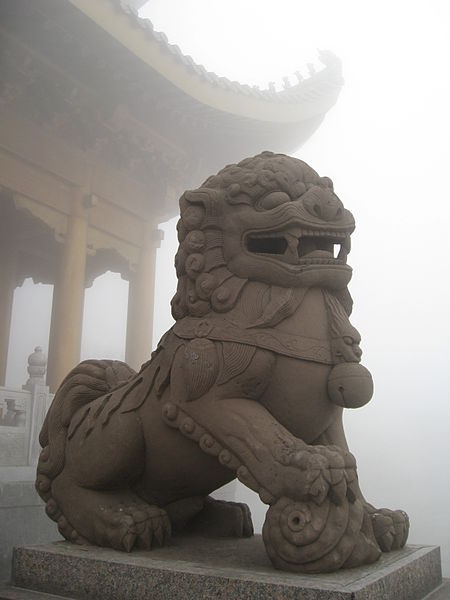
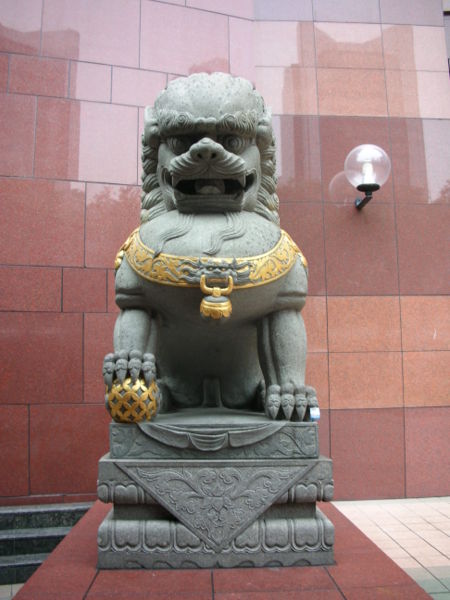
Xiu Qiu links to Temari
A bouncing ball that makes noise.
May have already linked but will again anyway just in case:
Flower of Life
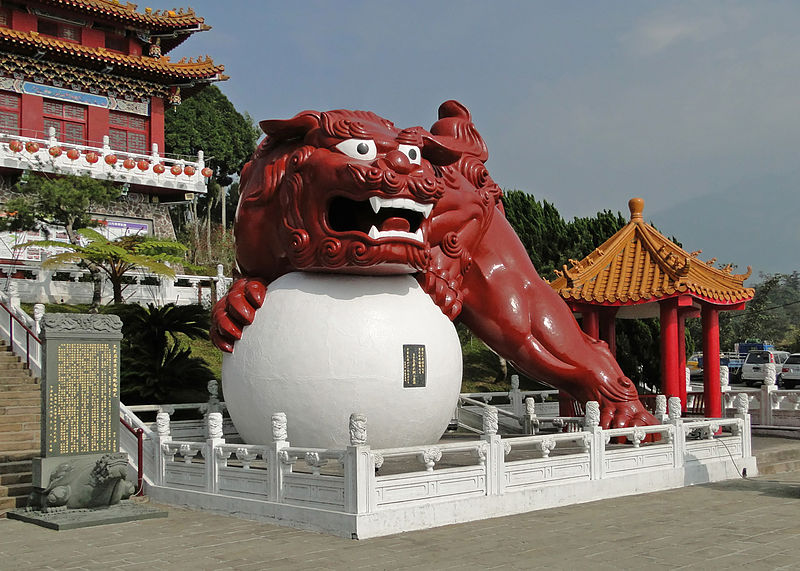
The Red Lion and the Priceless Pearl...
Thus we have Gargoyles which have water spouts, and Grotesques which do not..
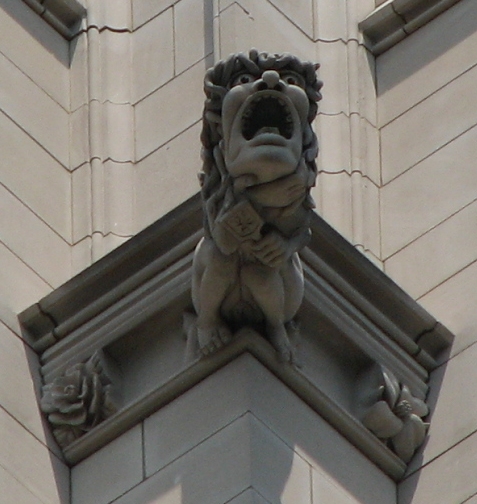
Medusa holding her own mirror screaming?
And we have the Sheela na gig , which are grotesques depicting naked women opening their vulva (yes on Churches of all places). You need to go to the link for those they are a bit "over the top".
Now check out the Google Images results of the legends of the Philippines Aswang Vampires
You will see they are striking similar to specific types of western winged-vampire Gargoyles/Grotesques. Pretty amazing correlation there.
Also of interest are types of Fish-Roof ornamentation in Asia such as the Onigawara and Shachihoko
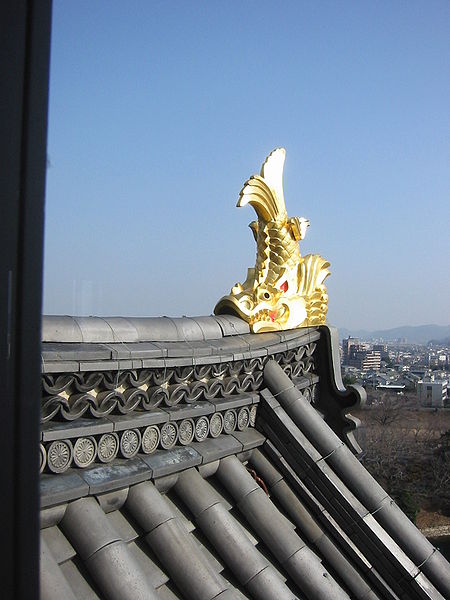


So what are we talking about here?
Guardians of Arcane Knowledge?

A statue of a guardian lion looking over Mount Emei, China

Imperial guardian lion outside Ngee Ann City in Singapore
The lions are always presented in pairs, a manifestation of yin and yang, the female representing yin and the male yang. The male lion has its right front paw on an embroidered ball called a "xiù qiú" (绣球), which is sometimes carved with a geometric pattern known in the West as the "Flower of life" The female is essentially identical, but has a cub under the closer (left) paw to the male, representing the cycle of life. Symbolically, the female fu lion protects those dwelling inside, while the male guards the structure. Sometimes the female has her mouth closed, and the male open. This symbolizes the enunciation of the sacred word "om". However, Japanese adaptions state that the male is inhaling, representing life, while the female exhales, representing death. Other styles have both lions with a single large pearl in each of their partially opened mouths. The pearl is carved so that it can roll about in the lion's mouth but sized just large enough so that it can never be removed.
According to feng shui, correct placement of the lions is important to ensure their beneficial effect. When looking out of a building through the entrance to be guarded, looking in the same direction as the lions, the male is placed on the left and the female on the right. So when looking at the entrance from outside the building, facing the lions, the male lion with the ball is on the right, and the female with the cub is on the left.
Xiu Qiu links to Temari
A bouncing ball that makes noise.
May have already linked but will again anyway just in case:
Flower of Life

A guardian lion of Wen Wu Temple, Taiwan
The Red Lion and the Priceless Pearl...
Thus we have Gargoyles which have water spouts, and Grotesques which do not..
Grotesques are often confused with gargoyles, but the distinction is that gargoyles are figures that contain a water spout through the mouth, while grotesques do not. This type of sculpture is also called a chimera.

Medusa holding her own mirror screaming?
And we have the Sheela na gig , which are grotesques depicting naked women opening their vulva (yes on Churches of all places). You need to go to the link for those they are a bit "over the top".
Now check out the Google Images results of the legends of the Philippines Aswang Vampires
You will see they are striking similar to specific types of western winged-vampire Gargoyles/Grotesques. Pretty amazing correlation there.
Also of interest are types of Fish-Roof ornamentation in Asia such as the Onigawara and Shachihoko

A shachihoko decorates the roof of Okayama Castle


So what are we talking about here?
Guardians of Arcane Knowledge?
edit on 13-9-2013 by muzzleflash because: (no reason given)
Want to discuss the blatant messages I hear screaming from these statues.

A Pearl is Trapped in it's Stone mouth seemingly impossible to reach. The Pearl of God out of reach yet so close!
The Guardian Lion has a Conch Shell under it's Paw.
And a Bell too just in case you couldn't hear it trying to get your attention.
Now, remember the story of the Labyrinth or of Alexander cutting the Knot?
Well, take the most direct and easiest route to getting to the Pearl of God.
Smash the proverbial statue within with a hammer.
Get the Pearl "Like a Thief in the Night", eradicate your idols.
"Take Medusa's Head Off" - so to speak, and use the Pearl of God within her mouth as a shield.
This is a hidden message "Destroy the Idol-Statue-Dogma to Reach God".
Get Creative!
The Riddle of the Sphinx = The Little of the Thinks
The Hindu Shankha Shell
Also of note::
Pearl + Conch = Trumpeting Chimera
It's loud, pay attention!

A Pearl is Trapped in it's Stone mouth seemingly impossible to reach. The Pearl of God out of reach yet so close!
The Guardian Lion has a Conch Shell under it's Paw.
And a Bell too just in case you couldn't hear it trying to get your attention.
Now, remember the story of the Labyrinth or of Alexander cutting the Knot?
Well, take the most direct and easiest route to getting to the Pearl of God.
Smash the proverbial statue within with a hammer.
Get the Pearl "Like a Thief in the Night", eradicate your idols.
"Take Medusa's Head Off" - so to speak, and use the Pearl of God within her mouth as a shield.
This is a hidden message "Destroy the Idol-Statue-Dogma to Reach God".
Get Creative!
The Riddle of the Sphinx = The Little of the Thinks
Many different kinds of molluscs can produce pearls. Pearls from the queen conch, S. gigas, are rare and have been collectors' items since Victorian times.[4] Conch pearls occur in a range of hues, including white, brown and orange, with many intermediate shades, but pink is the colour most associated with the conch pearl, such that these pearls are sometimes referred to simply as "pink pearls".[4]
Although non-nacreous, the surface of fine conch pearls has a unique and attractive appearance of its own. The microstructure of conch pearls comprises partly aligned bundles of microcrystalline fibres that create a shimmering, slightly iridescent effect known as "flame structure".
The Hindu Shankha Shell
In Hinduism, the shankha is a sacred emblem of the Hindu preserver god Vishnu. It is still used as a trumpet in Hindu ritual, and in the past was used as a war trumpet. The shankha is praised in Hindu scriptures as a giver of fame, longevity and prosperity, the cleanser of sin and the abode of Lakshmi, who is the goddess of wealth and consort of Vishnu.
The shankha is displayed in Hindu art in association with Vishnu. As a symbol of water, it is associated with female fertility and serpents (Nāgas). The shankha is the state emblem of the Indian state of Kerala and was also the national emblems of the Indian princely state of Travancore, and the Kingdom of Kochi.
The shankha is one of the eight Buddhist auspicious symbols, the Ashtamangala, and in Buddhism it represents the pervasive sound of the Buddhadharma. In Tibetan Buddhism, it is known as "dung kar".
Also of note::
In the Western world, in the English language, the shell of this species is known as the "divine conch" or the "sacred chank". It may also be simply called a "chank" or conch. The more common form of this shell is known as "left-turning" in a religious context, although scientists would call it "dextral". A very rarely encountered form has reverse coiling which is called "right-turning" in a religious context, but is known as "sinistral" or left-coiling in a scientific context.
Pearl + Conch = Trumpeting Chimera
It's loud, pay attention!
edit on 13-9-2013 by muzzleflash because: (no reason given)
edit on 13-9-2013 by muzzleflash
because: (no reason given)
new topics
-
Something better
Dissecting Disinformation: 51 minutes ago -
The Witcher IV — Cinematic Reveal Trailer | The Game Awards 2024
Video Games: 3 hours ago -
Friday thoughts
General Chit Chat: 4 hours ago -
More Ons?
Political Conspiracies: 4 hours ago -
Canada Post strike ended by the Government of Canada
Mainstream News: 4 hours ago -
They Know
Aliens and UFOs: 8 hours ago -
Drones (QUESTION) TERMINATOR (QUESTION)
General Chit Chat: 10 hours ago
top topics
-
They Know
Aliens and UFOs: 8 hours ago, 18 flags -
Canada Banning more Shovels
General Chit Chat: 13 hours ago, 10 flags -
Something better
Dissecting Disinformation: 51 minutes ago, 6 flags -
More Ons?
Political Conspiracies: 4 hours ago, 5 flags -
Friday thoughts
General Chit Chat: 4 hours ago, 5 flags -
Canada Post strike ended by the Government of Canada
Mainstream News: 4 hours ago, 3 flags -
The Witcher IV — Cinematic Reveal Trailer | The Game Awards 2024
Video Games: 3 hours ago, 2 flags -
Drones (QUESTION) TERMINATOR (QUESTION)
General Chit Chat: 10 hours ago, 1 flags
active topics
-
Something better
Dissecting Disinformation • 4 • : nugget1 -
A priest who sexually assaulted a sleeping man on a train has been jailed for 16 months.
Social Issues and Civil Unrest • 27 • : Astrocometus -
More Ons?
Political Conspiracies • 15 • : hangedman13 -
The Witcher IV — Cinematic Reveal Trailer | The Game Awards 2024
Video Games • 3 • : stosh64 -
They Know
Aliens and UFOs • 52 • : argentus -
Canada Banning more Shovels
General Chit Chat • 9 • : VariedcodeSole -
President-Elect DONALD TRUMP's 2nd-Term Administration Takes Shape.
Political Ideology • 329 • : Oldcarpy2 -
Friday thoughts
General Chit Chat • 4 • : soulrevival -
Jan 6th truth is starting to leak out.
US Political Madness • 35 • : fringeofthefringe -
A Bunch of Maybe Drones Just Flew Across Hillsborough County
Aircraft Projects • 42 • : matafuchs
